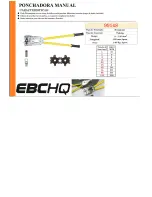
Remaining risks
m
Even if you use this electric power tool
in accordance with instructions, certain
residual risks cannot be rules out. The
following hazards may arise in connection
with the equipment´s construction and
layout:
1.
Lung damage if no suitable protective dust
mask is used.
2.
Damage to hearing if no suitable ear protec
-
tion is used.
3.
Health damage caused by hand-arm
vibrations if the equipment is used over a
prolonged period
Equipment Fig.1
1.
ON/OFF switch
1. Tool chuck
2.
Battery
3. Speed controller
4. Tool
Before starting the equipment
Fitting the plug-in tools
•
To fit the plug-in tools safely you should
hold the multifunction tool so that the ON/
OFF switch (Fig.1.Pos.1) points down
and the tool mounting (Fig.1.Pos.2) faces
up.
•
Place the plug-in tool (e.g. the triangu-
lar sanding/grinding plant) on the tool
mounting (Fig.1.Pos.2) so that the pins of
the tool mounting (Fig.1.Pos.2) fit into the
recesses in the plug-in tool.
•
Secure the plug-in tool using the supplied
screw and tighten the screw securely with
the Allen key.
•
Make sure that the washer is used for the
screw.
•
Check that the plug-in tool is secure.
Starting up
Switching on/off
Slide the switch (Fig.1.Pos.1) forwards to
switch on the equipment.
Practical tips
•
Switch on the equipment.
•
Work away from the body.
•
Never move your hands into the direct
vicinity of the work area.
•
Use only plug-in tools which are in good
working order and undamaged.
Plug-in tools
Sawing:
Sawing wood and plastic. Notes on
working practice: When sawing, watch out
for foreign bodies in the material and remove
them if necessary. Plunge cutting is allowed
only in soft materials such as wood or plaster
-
board.
Sanding/grinding:
Surface sanding/grinding
at edges, in corners or hard-to-reach areas.
Depending on choice of sanding/grinding
paper for the sanding/grinding of wood, paint,
lacquer, etc. Notes on working practice: This
equipment offers particularly high performance
for the sanding/grinding of hard-to-reach
corners and edges. To sand/grind profiles
and channels you can also work with just the
tip or the edge of the sanding/grinding disk.
Various sanding/grinding papers are availa
-
ble, specially designed for the different types
of material you may be working on and the
amount you wish to remove from the surface.
The amount removed will depend largely on
the choice of sanding/grinding paper and pres
-
sure applied to the sanding/grinding disk.
Scraping:
Scraping off old paint or adhesives.
Notes on working practice: Move the plug-in
tool against the area you want to remove.
Begin with a flat angle of incidence and little
pressure. The surface (e.g. wood, plaster) may
be damaged if too much pressure is used.
Diamond saw blade:
For small repairs to tiled
areas indoors and to brick walls. Notes on
working practice: Work only at high oscillating
speed.
Speed control
You can select the speed by turning the speed
controller (Fig.1.Pos.4).
Cleaning
Always pull out the power plug before star-
ting any cleaning work.
•
Keep all safety devices, air vents and the
motor housing free of dirt and dust as far
as possible. Wipe the equipment with a
clean cloth or blow it down with com
-
pressed air at low pressure.
•
We recommend that you clean the equip
-
ment immediately after you use it.
•
Clean the equipment regularly with a
damp cloth and some soft soap. Do not
use cleaning agents or solvents; these
may be aggressive to the plastic parts in
the equipment. Ensure that no water can
get into the interior of the equipment.
Storage
•
Store the equipment and accessories out of
children’s reach in a dark and dry place at
above freezing temperature. The ideal storage
temperature is between 5 and 30 °C. Store the
electric tool in its original packaging.
GB
13
Содержание 5909204900
Страница 2: ...2 ...
Страница 3: ...Fig 1 1 2 3 5 4 3 ...














































